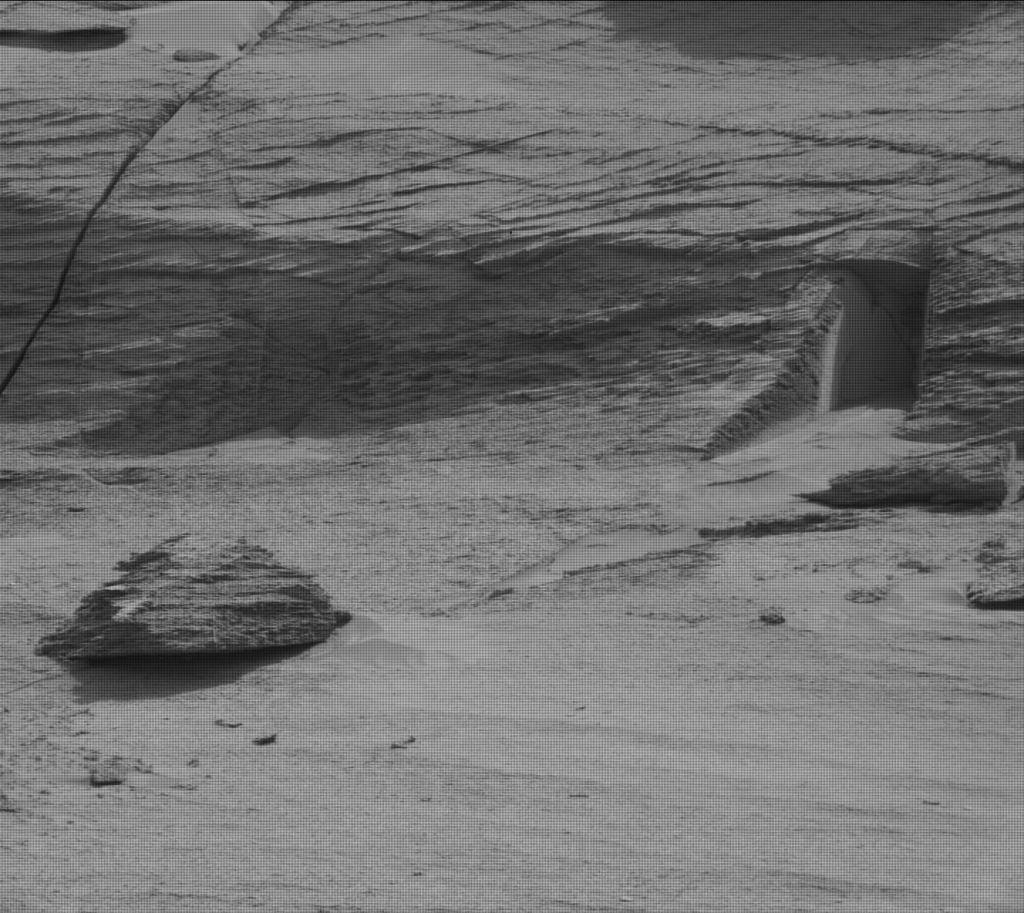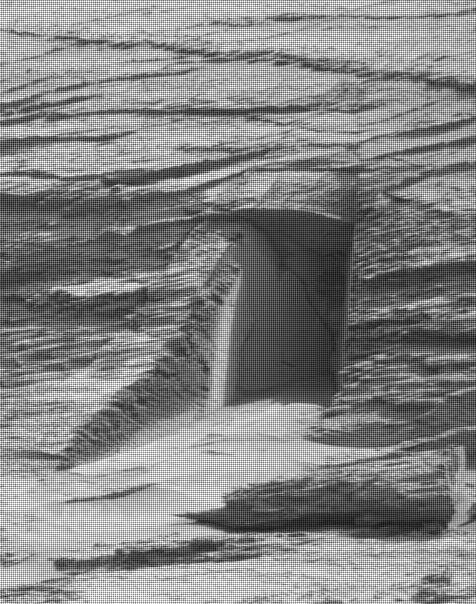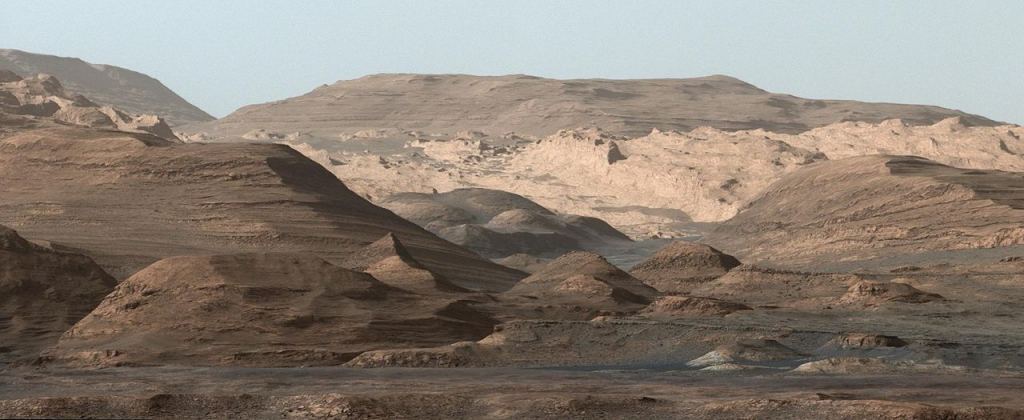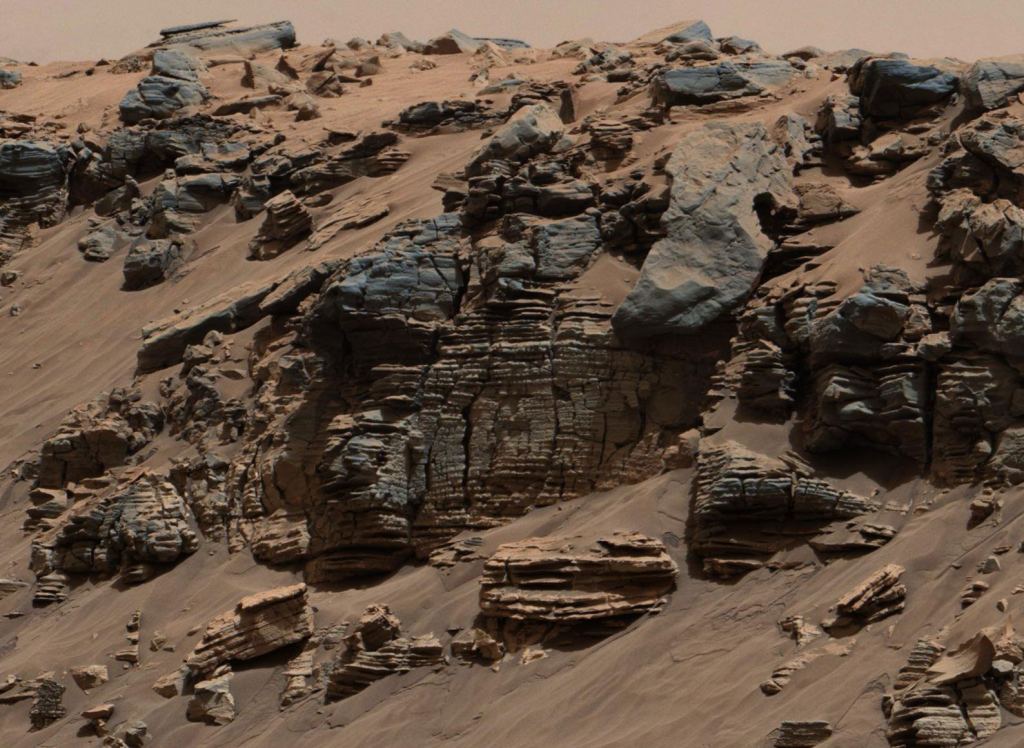 A Mastcam image from the Mars Curiosity rover captures what looks like a doorway into a rock ledge. It was formed when layered rock cracked and eroded away. Courtesy NASA Mars Curiosity Rover team.
A Mastcam image from the Mars Curiosity rover captures what looks like a doorway into a rock ledge. It was formed when layered rock cracked and eroded away. Courtesy NASA Mars Curiosity Rover team.
The planet Mars has a lot of intriguing geological features, but a doorway in the side of some sedimentary rock on the flank of Mount Sharp (Aeolis Mons) isn’t one of them. In fact, no such doorway on Mars (supposedly created by aliens) exists. But, there is a break in the rock that really, really does look like one. The fact that it isn’t a real doorway hasn’t stopped a lot of speculation over its appearance in an image snapped by the MastCam on the Curiosity rover on Sol 3466 (May 7, 2022). The plain truth is that the odd-looking feature is really a fracture in ancient layers of sand that have hardened into rock over millions of years. A combination of light, shadow and viewing angle makes it look like a door. But, it’s not.
 A closeup of the purported doorway on Mars shows the structure of the rock, cracks inside the broken area, and sand deposits nearby. Cutaway from the Mastcam image by C.C. Petersen.
A closeup of the purported doorway on Mars shows the structure of the rock, cracks inside the broken area, and sand deposits nearby. Cutaway from the Mastcam image by C.C. Petersen.
It’s not the first time an odd “something” on Mars, or other places in the solar system (including Earth), has caught people’s attention. People are familiar with the “Face on Mars” furor over a purported alien face on the planet. It turned out to be nothing more than an eroded mesa in the Cydonia region. But, that didn’t stop a small cottage industry of writers and speakers from pushing the idea that ancient aliens built it as a signal to us (or something). Subsequent missions that imaged the surface showed that there are no faces on Mars. And, there aren’t any statues or spoons, or other spooky objects either. In every case, the objects that people thought they saw turned out to be ordinary rocks or rock formations.
A Science Doorway on Mars
 A composite image of Mount Sharp in Gale Crater, created by NASA’s Curiosity Rover in 2015. The rover is currently atop a region called Greenheugh Pediment on the mountain, which is where it snapped the image of the “doorway on Mars” that has excited people’s imaginations. Credit: NASA/JPL-Caltech/MSSS
A composite image of Mount Sharp in Gale Crater, created by NASA’s Curiosity Rover in 2015. The rover is currently atop a region called Greenheugh Pediment on the mountain, which is where it snapped the image of the “doorway on Mars” that has excited people’s imaginations. Credit: NASA/JPL-Caltech/MSSS
There are a lot of really cool features on Mars: rock formations, river beds, volcanoes, and craters. They provide more than enough exciting science, so we really don’t need mysterious “visions” that stem from overactive imaginations and the very human tendency to see shapes or make pictures out of random or ambiguous visual scenes. (The technical term for that tendency is pareidolia.) We’ve covered that term before, in stories about the Moon and other interesting objects in space.
In a way, the purported “mysterious door” rock feature on Mars gives us a chance to do a quick review here about what the Curiosity rover has helped scientists discover. Currently, it’s exploring the central mountain in Gale Crater. There are some pretty familiar-looking scenes there and that familiarity does provide us with a doorway to understanding ancient and current Mars, and how it got the way it is.
Recognizing Familiar Things on a Distant World
We see a LOT of sandstones and other sedimentary rocks on Mars, particularly in the area Curiosity is exploring. They look familiar to us because there are similar rocks here on Earth. Understanding how they formed here opens a door to an understanding of how they formed on Mars. Similar processes were involved in both cases: deposition and erosion by water and wind. By observing such materials here at home, and how they behave, we can get a good feel for what’s happening to the “sibling” rocks on Mars.
For example, if you are familiar with sandstones here on Earth, you know they can break pretty easily into sharp shards. Anyone with a sandstone sidewalk is probably quite aware of how fragile the stuff can be. So, seeing similar types of rock fractured and broken on Mars isn’t a surprise. But, seeing it break into such a strange shape certainly did get a lot of attention, which we can use to learn more about Mars.
Understanding the Geology of the “Doorway on Mars”
The region that Curiosity is traveling through right now is called the Greenheugh Pediment on Mount Sharp. When the Mastcam caught the image of the “doorway on Mars”, it was looking at a series of rocks that began life as sand dunes. They were probably deposited by what geologists call “aeolian processes.” That means “wind action.” Over time, they hardened into solid rock. Then, in one small area, something caused the rock to fracture in a couple of places. It probably wasn’t anything mysterious, perhaps a little Marsquake or some other natural process. The blocks of rock eventually moved apart, and that left behind what looks like the door.
The Greenheugh Pediment is part of Mount Sharp, which is itself a 5.5-km-high mound of sedimentary layered rock. Curiosity has been traversing the Pediment, studying the topmost layers of sandstone. There is evidence of clay-bearing rocks in the region as well. Just as it began its trip up the mountain some years ago, Curiosity found evidence for mudstones—rocks that could only form in the presence of water.
Building Mount Sharp
The story of Mount Sharp is still unfolding, but here’s what planetary scientists think happened to form it. First, Gale Crater formed more than 3.5 billion years ago when an asteroid or comet hit the planet. Aeolis Mons is the central peak of the crater and it rises up about 5.5 km. (By comparison, Mount Everest on Earth is 8.8 km high).
Over millions of years, water flowed from the northern rim of the crater into the center. That deposited sediment on the floor of the crater. Flowing water created the mound of debris that makes up Mount Sharp. Certainly, some materials were deposited in the region by wind action, too.
As it treks along, Curiosity is exploring the remains of the mound that comprises Mount Sharp. The discovery of the break in the rocks that looks like a doorway on Mars is part of its exploration of the Gale Crater and Mount Sharp rocks.
 Another Mastcam view of eroded sedimentary rocks (likely deposited long ago on the floor of a lake in Gale Crater). This scene is not far from where water flowed into the lake. Credit: NASA/JPL-Caltech/MSSS
Another Mastcam view of eroded sedimentary rocks (likely deposited long ago on the floor of a lake in Gale Crater). This scene is not far from where water flowed into the lake. Credit: NASA/JPL-Caltech/MSSS
Curiosity Opens More Doors of Discovery
The exploration of the Greenheugh Pediment is only the latest of Curiosity’s explorations. During its time on Mars, the rover has been a veritable geology lab. It has found evidence of flow features made by wet brines. (Brines are salty fluids.) It also found clues to the ancient lakes and streams that filled the crater. And, that contributes to the larger story of water on Mars. It played a role in laying down layers of what became hardened sedimentary rock.
There’s been a lot of speculation that such a lake could have welcomed and nourished microbial life at one time. There’s no proof that life existed, yet. The search for that life and the environments where it could have flourished is, in part, why NASA and others have sent spacecraft to Mars. Despite the fact that this place is a dry and dusty desert planet today, its history still intrigues us. And, if the rocks break into interesting shapes as they erode and scatter, maybe that’s a good thing—it grabs people’s attention and creates our fascination with the ever-changing story of the Red Planet.
For more Information
Curiosity’s View from the Top of the Greenheugh Pediment
Gale Crater (Wikipedia)
Mars Curiosity Lander page (NASA)
Sol 3466: Mast Camera (Mastcam) view of the “door” formation

